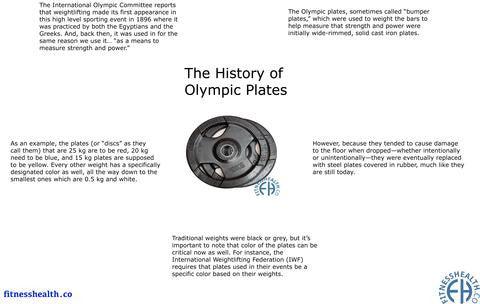
Most of us go to the gym, use the equipment, and then leave without even once wondering how the objects we engaged with were created. Our only thought is on our fitness, and likely what we need to do or not do to improve it. However, if you’re a history buff (or simply curious about how the things you use were invented), then here’s a little lesson on Olympic plates.
The International Olympic Committee reports that weightlifting made its first appearance in this high level sporting event in 1896 where it was practiced by both the Egyptians and the Greeks. And, back then, it was used in for the same reason we use it… “as a means to measure strength and power.”
The Olympic plates, sometimes called “bumper plates,” which were used to weight the bars to help measure that strength and power were initially wide-rimmed, solid cast iron plates. However, because they tended to cause damage to the floor when dropped—whether intentionally or unintentionally—they were eventually replaced with steel plates covered in rubber, much like they are still today.
Traditional weights were black or grey, but it’s important to note that color of the plates can be critical now as well. For instance, the International Weightlifting Federation (IWF) requires that plates used in their events be a specific color based on their weights. As an example, the plates (or “discs” as they call them) that are 25 kg are to be red, 20 kg need to be blue, and 15 kg plates are supposed to be yellow. Every other weight has a specifically designated color as well, all the way down to the smallest ones which are 0.5 kg and white.
There you have it…the story of how Olympic weights came to be. Now you know.









